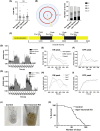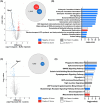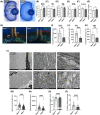Novel in vivo models of autosomal optic atrophy reveal conserved pathological changes in neuronal mitochondrial structure and function
- PMID: 40202868
- PMCID: PMC11981028
- DOI: 10.1096/fj.202403271R
Novel in vivo models of autosomal optic atrophy reveal conserved pathological changes in neuronal mitochondrial structure and function
Abstract
Autosomal optic atrophy (AOA) is a form of hereditary optic neuropathy characterized by the irreversible and progressive degermation of the retinal ganglion cells. Most cases of AOA are associated with a single dominant mutation in OPA1, which encodes a protein required for fusion of the inner mitochondrial membrane. It is unclear how loss of OPA1 leads to neuronal death, and despite ubiquitous expression appears to disproportionately affect the RGCs. This study introduces two novel in vivo models of OPA1-mediated AOA, including the first developmentally viable vertebrate Opa1 knockout (KO). These models allow for the study of Opa1 loss in neurons, specifically RGCs. Though survival is significantly reduced in Opa1 deficient zebrafish and Drosophila, both models permit the study of viable larvae. Moreover, zebrafish Opa1 KO larvae show impaired visual function but unchanged locomotor function, indicating that retinal neurons are particularly sensitive to Opa1 loss. Proteomic profiling of both models reveals marked disruption in protein expression associated with mitochondrial function, consistent with an observed decrease in mitochondrial respiratory function. Similarly, mitochondrial fragmentation and disordered cristae organization were observed in neuronal axons in both models highlighting Opa1's highly conserved role in regulating mitochondrial morphology and function in neuronal axons. Importantly, in Opa1 deficient zebrafish, mitochondrial disruption and visual impairment precede degeneration of RGCs. These novel models mimic key features of AOA and provide valuable tools for therapeutic screening. Our findings suggest that therapies enhancing mitochondrial function may offer a potential treatment strategy for AOA.
Keywords: Drosophila; mitochondria; optic atrophy; visual impairment; zebrafish.
© 2025 The Author(s). The FASEB Journal published by Wiley Periodicals LLC on behalf of Federation of American Societies for Experimental Biology.
Conflict of interest statement
The authors declare that the research was conducted in the absence of any commercial or financial relationships that could be construed as a potential conflict of interest.
Figures








References
-
- Toomes C, Marchbank NJ, Mackey DA, et al. Spectrum, frequency and penetrance of OPA1 mutations in dominant optic atrophy. Hum Mol Genet. 2001;10(13):1369‐1378. - PubMed
MeSH terms
Substances
Grants and funding
LinkOut - more resources
Full Text Sources
Molecular Biology Databases
Research Materials

